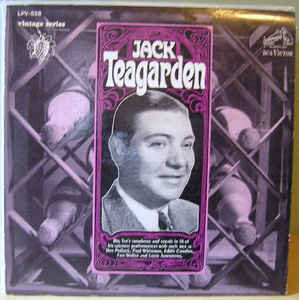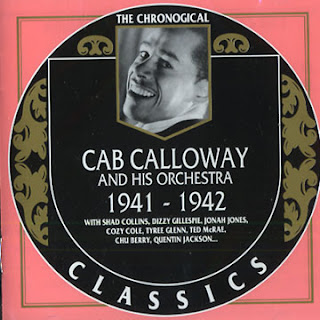Jack Teagarden
This 1968 compilation from RCA Victor's Vintage Series features trombonist and vocalist Jack Teagarden (1905-1964) on sixteen tracks in eleven different settings over a thirty year period, 1928-1957. I don't normally like these kind of compilations, especially those that cover a lot of ground, but since I'm not that familiar with his work it provides a nice overview. Except for two songs by his own group from 1947, he is a sideman or a guest on all of the tracks.
Teagarden was born into a musical family and raised in Vernon, Texas located in the northern part of the state on the border just south of Oklahoma. Being in the heart of the southwest, this means blues territory and it provides the basis for his music. More than any other white musician of his generation, he was exposed to African American music and culture from an early age and internalized the language, being able to play and sing the blues in an authentic manner. Though he is often remembered for his trombone playing, his singing is equally masterful and worth of study by aspiring male jazz singers.
His trombone playing is excellent and he developed a method of false fingerings that enabled him to play faster passages, a step forward for trombonists of his era. Not that he was inclined to show off his chops (he did), but it was more of a device he chose to use as his improvisations were vocal-like and focused on intensity and emotion. When he is playing in the low register, his tone is rougher as if he were speaking. It's not as articulate as his high register playing where his poignancy rings through. One of the more articulate trombonists of the pre-bebop era, his playing is simple and straightforward and he plays as if he was speaking words.
As a singer, Teagarden imparted that blues lament in everything that he sang. He was a natural singer who never seems to try too hard when he sings. His voice always had that world-weary "seen it all, done it all"-type of attitude, even on his earliest vocal tracks from 1929. But on the last tracks from 1957 with Bud Freeman's Summa Cum Laude Orchestra, the effect is powerful. "I Cover the Waterfront" begins with Teagarden improvising rubato with piano accompaniment. The power of his voice elevates the song to Billie Holiday-type levels. "There'll Be Some Changes Made" is the perfect song for him to sing, but even on this rousing version complete with collective improvisation ending, his vocal chorus still manages to convey a dark, sullen mood. No doubt, he was a poet.
The first track "She's a Great, Great Girl" from 1928 finds Teagarden playing with a sweet dance band with brass, two saxophones and two violins (including Joe Venuti who I believe takes a solo on this). Led by Roger Wolfe Kahn, Teagarden comes out of the gate running: showing off his technique, his sound, and his mastery of the blues. He sings and plays on two tracks with Eddie Condon's Hot Shots where pianist Joe Sullivan's solos are the other highlight. His rhythmic based improvisations groove hard and set a swinging tone with drummer George Stafford. Largely because of one of the more satisfactory drum tones I've heard on an early jazz record, his playing and fills come out nicely on "I"m Gonna Stomp Mr. Henry Lee",
Teagarden is also heard with Ben Pollack's groups. "My Kinda Love" from 1929 features an excellent solo that showcases upper register. His effect on the band is clear, propelling the rhythm section to groove harder and inspiring a young Benny Goodman to play some blues. "Two Tickets to Georgia" from 1933 features solos by Teagarden and Charlie Spivak on trumpet that overcome a pop vocal by guitarist Nappy Lamare.
Similarly, the Mound City Blowers two tracks from 1929 are enhanced not by Red McKenzie's gimmicky comb and paper solos but by Teagarden and the other musicians. Actually McKenzie's lines aren't too awful, but his sound, which was vaudevillian then, sounds downright awful today. Despite the comb, this group relied on the vibrant studio scene and, over the years, had a roster of superb musicians including tenor saxophonist Coleman Hawkins, Frankie Trumbauer, Jimmy Dorsey, Bunny Berigan, Glenn Miller, and many others.
Teagarden takes a strong solo on "Never Had a Reason to Believe in you" and on "Tailspin Blues" he showcases his "glass and trombone" trick wherein he replaces the bell of the horn with a glass. A gimmick, it ends up sounding quasi-muted and is pleasant enough. The other highlight is Al Morgan on bass. From a musical family, he played and recorded with his brother, Sam Morgan, as well as Cab Calloway, and Fats Waller. He is from New Orleans and that city has bred a significant amount of early jazz bassists including Steve Brown, Pops Foster, Wellman Braud, John Lindsay, Sidney Brown, Bill Johnson, and a host of others who have not recorded. Here Morgan displays a strong tone and even plays a few fills behind Teagarden.
"Ridin' But Walkin'" from 1929 was performed by Fats Waller and his Buddies. Most of Luis Russell's Orchestra are here and the band's rhythm section of Kaiser Marshall on drums and Pops Foster on bass provides a strong groove throughout including a a swinging finale. Foster is excellent here playing double time and eighth notes. Besides, Teagarden who sings and solos, Henry "Red" Allen's trumpet solo is noteworthy.
Paul Whiteman's "Nobody's Sweetheart Now" from 1935 is a feature for Teagarden who dominates the track. He is also heard as a special guest with Louis Armstrong in 1947 on a strong version of "St. James Infirmary" where, strangely, we do not hear Armstrong at all. Teagarden's two tracks from 1947 features his strong band. "A Jam Session" is an inspired performance and is powered by drummer Dave Tough who sets the tone with four bars up front. Besides Teagarden, there are excellent solos by Max Kaminsky on trumpet, an excellent one by Peanuts Hucko on clarinet, Gene Schroeder on piano, and Cliff Strickland and his Lester Young-sound.
The other two tracks are from the first Metronome All-Stars band from January 11, 1939. Benny Goodman's solo on "The Blues" is strong as is the trumpet solo by Spivak on "Blue Lou". Perhaps the most noteworthy point, besides the excellent playing, is the fact that it's an all-white band. Metronome All-Stars are poll winners voted in by fans. Featuring members of all white bands including Benny Goodman, Tommy Dorsey, Glenn Miller, Casa Loma Orchestra, and others, shows how much more visible these groups were. With Benny Carter and Charlie Christian being voted in in 1940, the all-stars become more integrated but it's a very telling clue to how African American bands were treated or known amongst white audiences---or at least among the reading viewership of Metronome magazine.






Comments
Post a Comment